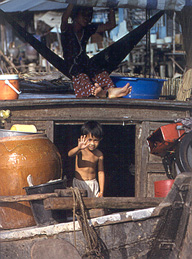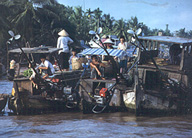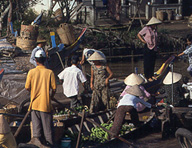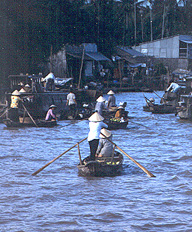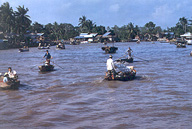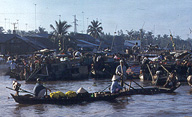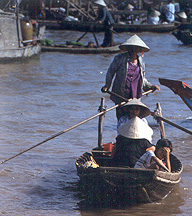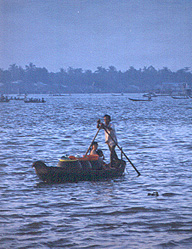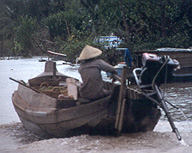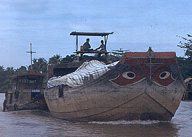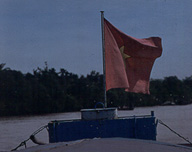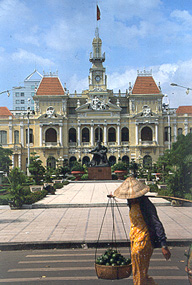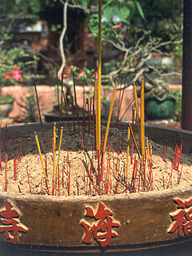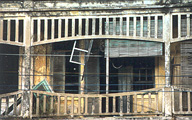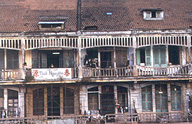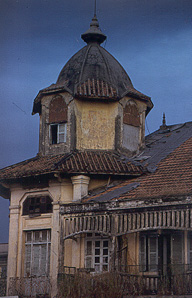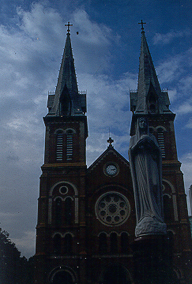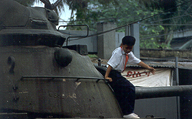Chapter 1 - Vietnam
The first hailstone landed to our right. We were both so incredulous at its size, its sudden unannounced arrival that we did not contemplate the obvious - that there would be more. We were quickly aroused from our daze as all about us the ground began to ping with their arrival. A nearby stream was churning under this heavenly barrage, its water seemingly raked by automatic gunfire. The size and concentration of these hailstones was awe-inspiring, but all fascination was stung out of me when I was hit square and hard in the back, as if by a squash ball. This was the beginning of the end.
That was a day high on the remote Tibetan plateau that I shall never forget. In fact had I been blessed with foresight I might never have embarked on the journey in the first place, I might have succumbed to the doubts and questions of family and friends. And Ian and I certainly did receive many doubts and questions when we broached the subject that we would wanted to journey from the mouth of thte Mekong River in Vietnam to its source over 5,000km away on the Tibetan plateau.
It was not just that it was the Mekong. It was that fact that it was a very long way and through a part of the world that had only recently achieved a tenuous stability. It was the fact that we wanted to travel from the mouth to the source, in other words the hard way. But especially, it was because we wanted to do it by bicycle. We were inundated by a stream of questions, which ranged from the honest “Where is the Mekong?” to the unimpressed “Why do you want to do that.” From the sarcastic “Cycle up the Mekong? You are going to cycle up a river on a bicycle?” to the obvious “From the mouth to the source. That means that you will be going uphill?”
What possessed us to think that we could succeed where no one had succeeded before? Henri Mouhout, albeit in the nineteenth century, was the last man that we knew of to try to travel the length of the Mekong. His fateful expedition ended with his death just outside Luang Prabang in Northern Laos. More recently the French explorer Michel Peissel, who discovered the source of the Mekong in 1996, said in his book ‘Last of the Barbarians’, “The truth of the matter is that no one has ever been allowed to follow the river along the whole of its course.” Surely it was foolhardy to even contemplate such an endeavour?
“Yes,” is probably the honest answer, but that is before you take into account Ian. Full responsibility for the trip must lie with Ian - it was his hair-brained scheme. It was an idea that he no doubt hatched on a dull winter’s afternoon whilst seated at a desk in an unexciting office in the middle of London, dreaming of bigger and greater things. Ian certainly has a fervent imagination and I am sure that his daydreams take him gallivanting around the world in a number of heroic guises. The words of Conrad’s Nostromo come to mind, “But, then, don’t you see he’s an Englishman...Simply that he cannot act or exist without idealising every simple feeling desire or achievement. He would not believe his own motives if he did not make them first a part of some fairytale.”
Though I jest at Ian’s romantic ideals and his boy’s own sense of adventure, he is at least prepared to try and make his dreams come true no matter how outlandish. Hence he set about talking to friends about his plans and how he could try to realise them. I was touted by some as being unhinged enough to consider the prospect. We were put in touch by mutual friendas and agreed to meet one Saturday evening to talk about the idea. We met in the Havelock Tavern, alcohol being a necessary ingredient in the hatching of such plans. By the end of the evening I had been enthused by Ian and his vision of traveling up the Mekong. No doubt the Guinness helped.
I think Ian found it hard to believe that someone was actually willing to share in his goal, thus I received a phone call a few days later to confirm my interest. Before I knew it I was committed. We were measuring out mileage on a map, thinking of sponsorship, the various angles that we would have to cover and prepare for, our imaginations lost in the realms of exploration. It was all one big adventure, as yet distant and far off.
A medical and basic survival course with the army quickly brought us down to reality. It made us realise the exacting ardours of independent travel in such far-flung place - that we would have no recourse to facilities and amenities that we have come to expect so much of back here at home. Our initial vision of the oncoming expedition and the trials that we would face was, in hindsight, naive to say the least. Yet despite all our doubts and critics we were prepared to give it a go.
Ok, we were going to give it a go, but why the Mekong? Again the blame must lie with Ian and an innocuous holiday to Vietnam that fired his imagination and got him thinking on a bigger scale. For me there were a number of attractions. Firstly, that Southeast Asia had only recently opened up to independent travel, and as yet the region was relatively untouched by the footsteps of other travellers. Secondly, that I knew little of the area as a whole. This seems a crazy reason but the fact that I knew relatively little about the Mekong was a big pull – we know so much about the Nile, the Amazon and the Yangtze but not of the Mekong. Thirdly and sadly, there are big plans afoot that aim to transform much of the region. It was this last reason that sealed the decision for me and meant that it was no good putting it off until another time.
*
In the early 1970s Saigon airport was one of the busiest in the world, today it is a hollow reminder of that past, its hangars a familiar image of film. Arriving at Ho Chi Minh airport was unsettling. Not just because we were now in a foreign country and our surrounds were alien, but also because this was where it all began. We were both filled with a boyish excitement.
Leaving the pedantry of airport bureaucracy behind, we were immediately submerged into the flow of perpetual traffic, consumed by the steady stream of scooters jockeying for position. They swim, swarm, weave and dart, a ceaseless stream of continual movement. Velocity, the force of numbers and the random movement defy all theories of collision. The city is consumed day and night by this ebb and flow of motorbikes, mopeds, scooters, bicycles and the lethargic cyclo, a tricycle pedicab. They swim in schools, in unison, alongside islands of corporate Land Cruisers and crammed buses, darting into some unseen corner at the slightest fright. The traffic is buzzing, it does not stall and choke but surges and pulsates. Acceptance, giving way is the creed, none of the obstinacy, aggression and foul language that pollutes our roads.
There is no limit to the variety of scenes that whiz past on scooters, no restrictions on numbers of passengers and/or cargo. Fridges, televisions, piles of pineapples, concrete blocks, exhausted ducks, panes of glass, chickens stuffed in wire mesh cages are some of the paraphernalia on the move. A plump, spoilt schoolboy greedily scoffs a snack behind his mother’s back. A family of four heads home, the two young children standing precariously on the crossbar between father’s legs. An elderly man wobbles past, pedalling slowly a bag of potatoes perched between his legs. A baby is passed from back from father to mother. A glamorous young woman is seated sidesaddle, legs crossed, nonchalant in the extreme. All are on the move.
The Vietnamese, more especially the women, look immaculate as they go about their daily business. They are elegant and have an erectness of posture that gives them an impressive bearing. Their clothes are simple, clean and pressed not flashy, crumpled or drenched in sweat. The ultimate in chic is the aodai, the national dress, which is a close loose fitting blouse with long panels in the front and back that is worn over loose trousers. The preferred material is white silk that enchants the wearer with a swan-like grace. Some are also partially see through, thus not only are they stylish but provocative.
On every street corner, outside every large official building lurk several getaway scooters, their owners on a state of alert, ready to make their exit. At any moment I expect there to be an explosion, doors to bang open, masked robbers to burst out running, jump onto the waiting motorbikes and speed off into the distance. If Saigon was a city under siege then Ho Chi Minh is a city under a state of perpetual heist. However the reality is much more urbane – they are scooter taxis touting for business.
*
Today, our first full day in Southeast Asia, we had decided was going to be a day of acclimatisation, a day of getting to know Ho Chi Minh. So we set off walking and exploring the city, lapping up what it had to offer with eagerness. The city itself is not as built up and modern as I had expected. I had thought that it might parallel some of the bigger Chinese cities, but there is not the same scale of construction and thankfully not the same proliferation of tiles and blue glass. There are a few high-rise buildings, modern and gleaming, but they are the exception rather than the rule. Undoubtedly there will be more, but at present the skyline is nicely down to earth.
Ho Chi Minh has the trappings of western entertainment but has not sold out to commercialism. It is not thankfully inundated by the likes of Macdonalds and Kentucky Fried Chicken. I do not know whether this is because they were not welcomed or simply did not want to invest in Vietnam - US companies pay an extra fifty per cent duty over and above what other countries pay. Having said that Ho Chi Minh is not devoid of western influence. This is especially true of its nightlife, which is not shy.
Seated on the roof terrace bar of the Caravelle Hotel looking out over the glittering lights of the city below Ho Chi Minh is like the Las Vegas of Southeast Asia. Cold imported beers, peanuts, smart waitresses attendant in aodais. It reeks of sophistication. The circuit of bars is laced with the trappings of the good life, easy women, fast money and inebriated expatriates. ‘The Globbo’ has green jello shots of vodka to fuel the spirit. Alcohol is poured on the bar than set alight. A Frenchman struts his stuff on the bar (unfortunately not when it is alight). A couple swing in Siroque. Outside the Vietnamese chauffeurs and cyclo drivers stare in, in disbelief. Then it is on to the ‘Gecko’ bar with its potent flaming Lamborghini that push one over the edge and pretty barmaids speaking colloquial English. Lethal injections of cocktails are administered orally by a pony-tailed Vietnamese man brandishing a large syringe. For those still standing it is on to ‘Apocalypse Now’, the last stop, where everyone meets up to dance the night away in an alcoholic blur or play pool and try to focus on an ever-increasing number of balls.
Throughout the city there is an attractive sprinkling of French colonial buildings. Many of these buildings, such as the church of Notre Dame, must have been huge and imposing at the time of their construction at the end of the nineteenth century. Presumably that is exactly what the French wanted to do - to impose themselves both physically and mentally on the Vietnamese. Whatever the ugly history behind these buildings they have evolved from beast to beauty, and now grace the otherwise humming city with a tranquil air.
On the other extreme are the streets of Cholon, which are far from tranquil. Loosely referred to as the Chinese district, the streets of Cholon are teeming with activity and the buzz of commerce. Here more than anywhere typifies the stereotypical image of a market of the Far East – pressing crowds, conical hats, and baskets of fresh produce, industry and noise. The shops are brimming over with goods, shelves are tightly packed, every nook and cranny is used, there is no space wasted. The excited chatter of transactions and the bustle of business fill the air. People are absorbed in the hubbub of frenzied sale, so much so that I wander around unnoticed, unphased by my camera and me.
Going by the descriptions of the 1950s of Norman Lewis, Cholon has lost little of its character and diversity. “One has been accustomed to crowds, to the spectacle of vast gatherings of people in the streets, in places of entertainment, in railway stations or restaurants. But such crowds have all been, more or less, engaged in a similar kind of activity. Here it was the diversity of occupation that was so remarkable. There must have been many hundreds of people in sight, all busy living their own lives and most of them independently of the actions of others in their immediate neighbourhood.”
The streets are fairly wide, thus despite the numbers and congestion, there is strangely an impression of space. The pavements on the other hand do not have the width of the streets, or at least do not give that impression. This is partly because the pavements have become an extension of the shops and restaurants, which spill out on to the walkway and because makeshift stalls and restaurants have been set up. Anything goes. There are hairdressers with a mirror hung on the wall and plastic sheeting to provide some cover and a little privacy from the passing traffic. Hair dryers and wash and cut are not in the vocabulary of the Vietnamese street barber.
The street corners are the preserve of the bicycle repairman or the motorbike mechanic. Their only means of advertisement an ancient bicycle pump, a couple of tyres stacked on the ground and a scattering of spare parts that have had new life breathed into them and can somehow be used again. At least you know that you get value for money as you pay purely for the labour, there being no overheads.
Restaurants defy the health and safety standards of western gastronomes and are equally happy to share the pavement with the hairdresser and the bicycle repairman. Seated on Lilliputian stools the Vietnamese slurp their noodles and tea, whilst they chat about life as the traffic roars past. These street-side restaurants are cramped, confined and not for the fainthearted. Yet the food is good and probably prepared in conditions not dissimilar to the restaurants frequented by the expatriates and travelling fraternity. A health and safety officer might despair but then everything that we eat back home is so sanitised and processed that we do not build up any sort of resistance or antibodies.
At night the hairdresser has departed, the bicycle repairman has packed away his tools, leaving the restaurant, a naked light bulb spotlighting the scene. The scene has changed from one of people gorging themselves s on food to people gorging themselves on violence. The television is on full blast and a crowd has gathered to ogle – it is the Vietnamese equivalent of the drive-in cinema. Sound is the key. It has to be loud to attract the attention of a passer-by and after that the action and thrills of the screen violence engross the viewer. There are restaurants that choose to be different by abstaining from violence and opting for a soap or sport, but they are certainly in the minority.
And yet despite all this screen violence, one of the first things that struck me about the streets of Ho Chi Minh was the lack of police presence, or at the very least uniformed police presence. Wandering aimlessly about the streets it is rare to come across a uniform, but according to the cynical, perhaps paranoid, expatriate there are a large number of plain-clothes police and everything is closely controlled. “Big brother is alive and well. And don’t you forget it.”
*
Setbacks are bound to occur on an expedition such as this, and we were mentally prepared for such eventualities as and when they should arise. But we did not expect setbacks so early in the trip. The plan had been to take a boat from the Mekong Delta to the Cambodian border with David Constantine, a quadriplegic and director of Motivation the charity for which we were raising money. We would then return to Hoi Chi Minh and cycle from there into Cambodia.
But there was one slight hitch – our bikes had been refused entry into Vietnam, as it is illegal to import bikes into the country. If we had brought our bikes on the airplane with us we would have had no problem, but DHL had very kindly agreed to fly them out separately. It was not a major setback only a minor disappointment, which meant that we would have to start cycling from Phnom Penh, where our bikes were being sent.
In order to forget our disappointment, we went to the War Museum. The War Museum fired thought, especially a disturbing collection of photos of the atrocities committed during the war. The evidence of deplorable acts was stark and brutal, and it was depressing to think of the depths to which man can sink. Yet it is easy for me to judge with the luxury of hindsight, a comfortable chair and beer whereas the reality of fighting a seemingly indestructible enemy in a totally alien environment must have been trying and unsettling in the extreme. I feel sorry for the naive good ole boys taken from their safe and familiar environment and thrown into the chaos and carnage of the jungle. I feel sorry for them but I do not excuse their behaviour – dragging prisoners behind tanks is barbaric and displays utter contempt for the enemy and human life. Each individual is responsible for his or her own actions but those in command must take much of the blame for breeding such hatred and disregard for Vietnamese life in their modes of warfare and policies of wanton destruction.
It made me reflect on the futility of war. I came away feeling that aerial bombardment causes much damage, destruction and devastation but rarely breaks the resolve of a country. Bombing raids will test a country’s will to fight to the limit but will not necessarily subdue a nation. Yet the Americans still insist on bombing Saddam Hussein to the verge.
Conversely the futility of war is clearly shown by the success of the American dollar and images of the US provided by big screen entertainment of Hollywood. It has surprised me the ease with which you can change and use dollars throughout the south of Vietnam. The dong and dollar are almost interchangeable in many parts of the country. This economic victory is an indication that the appeal of capitalism is far stronger and longer lasting than the bullet or the bomb.
*
The skies were foreboding and the humidity restricting. A light rustling of the trees whispered a break from the stalemate. But it was relief of a different kind as the heavens announced their anger with a vengeance. In defence, shelter was sought in shops and stalls, awnings were lowered hurriedly. There was a sense of some urgency, a race against the rain. A laden drop spits up dust. A pause, then another drop splashes angrily against the road. A shorter pause and then another drop. The momentum builds up, slowly at first, but quickly rising to a heavy drumming.
Unseasonal though it may be to have rain in January in Ho Chi Minh (in a more predictable and stable world climate, the monsoon in Vietnam would end with the month of October) it did not hold back. As I took refuge with numerous other pedestrians and cyclists in a clothes shop, the roads quickly began to swell to rivers as the drains were deluged, unable to cope with the flow. The rain of England is light, incessant and irksome that dampens both spirit and mind, whereas this torrent drenches body and only temporarily causes discomfort, having no long-lasting effect on the mind.
Some brave, perhaps foolhardy souls battled on against the elements, cloaked in capes of a rainbow of colours. As if from nowhere these capes, which had the amusing effect of transporting their owners onto the set of ET, appeared for sale on the street-side. Cheap and bright they added colour to the downpour but did little to protect. Cyclist and motorbike riders were quickly saturated not only from the heavens above but also by the wake of passing vehicles and the waterfalls gushing off the roofs of buses.
Most of the drowned rats soldiered manfully on, heads down, peering intently through the deluge. One woman sailed past, erect and head held up high, despite being wet through. As if in recognition of such defiance and elegance the gods bellowed their approval in an almighty thunderclap. Windows rattled, spines shivered, but it signalled a ceasefire and suddenly it was over. Crowds emerged from cover and life quickly reverted to its busy pace. The streets were left to drain and I was left with images of children on the backs of motorbikes cowering under the dryness of their mother’s cape.
*
We have been told that the boat will be ready for tomorrow so in the meantime we decided to see the sights outside of Ho Chi Minh. Heading out of town in air-conditioned splendour we quickly realised that the city is vast and sprawling, that its tentacles of wealth and promise reach out far and wide. The distinction between city and countryside is gradual and blurred. There was a slow lessening of neon, an increase in squalor and a less permanent feel to the suburbs and then we were out in the countryside. The contrast was great especially in terms of colour as we left behind the drab greys and dirty whites for the rich green of the fields. The paddyfields were a patchwork quilt drowning in a vibrant and verdant green. The colours spoke of productivity and yield.
The land is well ordered and organised. Every inch of land is utilised and the maximum benefit derived from it – there is no space wasted with vegetable plots lining the roadsides. And yet despite the pressure for land the ultimate sacrifice is made for the dead, they are given space. The fact that they are given land that could otherwise be cultivated when it is at such a premium is a measure of the strength of ancestor worship in Vietnam. But such a sacrifice is not without its price – three million dong is what it costs for burial. Thus many Vietnamese are now turning to cremation and spend their money on gravestones rather than plots of land. As a result the tombstone business is flourishing, as is the engraving and detail on many of them.
The roads are tarred and narrow, raised slightly above the wet wealth of the rice below. The distinction between the two lanes is non-existent in terms of the markings on the road and at best blurred between oncoming traffic. The extremities are reserved for the water buffalo, for peasant farmers off to their fields and cyclists, whilst the middle is left to the heavier, faster four-wheeled traffic. In the middle of the road traffic flows through an uncertain system of give and take, of patience and beeping before you can proceed. It is a system that works at present but for how much longer is arguable – increased volume of traffic will clog the intricate workings of the present system.
I say that it is a system that works, but every system has its hiccups. Ming, our driver, bluntly barked, “Accident. Dead.” A crowd had gathered in morbid fascination, in disbelief and in grief. All stood around a young boy who had been knocked off his bicycle. There was no offer of help for the boy, whose blood and life were oozing out. Ming mumbled thoughtfully to himself, pressed the accelerator and left us with the image of startled eyes staring at the sky. Ming the Merciless, as our driver now became known, had shown us all too clearly the frailty of the system of ducking and diving through the crowds and the dangers of cycling in Vietnam.
We were stood in front of a building that was so brightly coloured that we thought that we had come to the wrong place. It was a like a cartoon creation, a fantastical building that would not have looked out of place amongst the fairy castles of Disney World. Its interior offered no respite, and at best the decor could only be described as gaudy, garish and grotesque. Three naive, simple portraits of the Vietnamese poet Nguyen Binh Khiem, the Chinese nationalist Sun Yat Sen and Victor Hugo, also confronted us.
If you are a little confused as to our whereabouts then you are no worse off than we were at the time. In actual fact we were at the Caodaist temple of Tay Ninh. Caodaism is a bizarre fusion of religions that is eclectic in the extreme. The term Caodai literally means high tower or palace and it is a religion that was officially founded in 1926. Within a year the group had 26,000 followers and today there are some three million. Its hierarchy is partly based on the structure of the Catholic Church (though the position of pope has remained unfulfilled since 1933) and its doctrine is drawn from Buddhism with Taoist and Confucian elements.
The main tenets of Caodaoism include believing in one god, represented by the unsettling gaze of a technicolour eye, the existence of the soul and the use of mediums to communicate with the spiritual world. Caodai practices include priestly celibacy, vegetarianism, communications with the spirits through séances, reverence for the dead, maintenance of the cult of ancestors and sessions of meditative self-cultivation. Victor Hugo was posthumously canonised and named chief spirit of foreign missionary works because of his frequent appearances to Caodai mediums at the Phnom Penh mission. The clergy is open to both men and women, who wear white robes, and the male clergy are addressed as thanh, which means pure and the women as huong, which means perfume.
It is easy, especially given my atheistic cynicism to scoff at a religion that has canonised Victor Hugo because he has appeared at séances, that refers to its female members as perfume and that has remained rudderless since the 1930s. Given this and that the temple is emblazoned with such hideously over the top technicolour extravagance it was difficult to gain an air of solemnity that befitted a religion. But once inside the main hall of the temple we witnessed a service in progress and I was quietly taken by the simplicity of the service. It’s uniform order and especially the humble prostrations of the monks and nuns impressed me. Their prostrations were not dissimilar to the rakat of Islam, there being a real impression of submission to god, the meaning of Islam. Throughout the service a wooden time clapper provided rhythm to the melodic chanting of the congregation. The chanting had a droning hypnotic quality to it and I soon became consumed by the repetitive sound, which I suppose is the whole point, i.e. that the mind is concentrated to the extent that it dissolves into emptiness and hence meditation.
A female ‘perfume’ interrupted my trance-like state to ask me for a donation. It was not a donation for the temple, that I would have made and in fact did, but for her. My images of a puritanical life of monastic abstention shot out of the window as I left through the door, amused by this temple and my fleeting glimpse of Caodaoism.
Our next stop was Cu Chi, which is an impressive testament to the resilience of the Vietnamese and more specifically the Vietcong. It is not a triumphant communist edifice of concrete but a labyrinthine network of tunnels that totals two hundred and fifty kilometres in distance. The tunnels facilitated communication and coordination between Vietcong enclaves isolated from each other by South Vietnamese and American land and air operations. The tunnels gave rise to surprise guerilla attacks in the heart of the American territory that allowed the attacker to disappear almost without trace.
The tunnels were so effective that they enshrouded the Vietcong in invisibility and tormented the American troops to such an extent that the Americans in the last resort carpet-bombed the whole area. The bombing resulted in Cu Chi becoming “the most bombed, shelled, gassed and defoliated and generally devastated area in the history of warfare”(Tom Magnold). Magnold, a British correspondent, goes on to describe Bop Hope entertaining troops of the US 25th Infantry division on Christmas Day at Cu Chi. Whilst Bob Hope was entertaining the US above ground directly underground and at the same time a Vietnamese entertainer called Pham Sang was entertaining the Vietcong guerillas. In his book ‘The Perfect War’ James William Gibson states “The Vietcong’s tunnel system totally confounded American commanders.” This is clearly illustrated by Captain Nguyen Thanh Linh who describes how US forces responded to their first encounter with attack from the Vietcong hidden in the earth: “They were so bewildered, they did not hide or take defensive positions. They did not know where the bullets had come from.”
Arriving at Cu Chi, loud signs broadcasted the heroic achievement of the Cu Chi tunnels. If I had any doubts as to the nationalistic anti-American message that was about to be rammed down our throats then they quickly disappeared with the screening of a shameless video that preceded the tour of the tunnels. The video constantly referred to the ‘evil oppressors’, the devastation of helpless villages and how these ‘beautiful, young people’ were now taking the fight to the Americans. Awards were bestowed on ‘hero-killers of the Americans’. It was unashamed in its jingoistic message and the rousing march of the music only made things worse.
Having endured the video we were then taken to what remains of the tunnels themselves. The tunnels were an elaborate web that consisted of three levels, occasionally four, which were as deep as twenty metres. Descending into the first layer, the bombastic propaganda was left behind and the tunnels were allowed to speak for themselves. Only in the dim gloom, now lit for the benefit of soft tourists, could we see and understand what these tenacious people had endured by living for days on end in such cramped conditions. Cramped is an understatement and given the extreme confines their use of space was both remarkable and ingenious. There were elaborately constructed conference halls, food, storage and work depots, there were field hospitals and kitchens with vents that led to smoke outlets several hundred yards away - reducing and diffusing smoke emissions and thus the threat of discovery. A portion of the tunnels even ran underneath the riverbed.
If the dark of the chambers was oppressive then the overwhelming blackness of the interconnecting tunnels was constricting and claustrophobic. No more than two feet wide and a couple of feet high these tunnels caused us to hunch painfully over, our heads and backs banging against the hard earth ceiling. At times scrambling on all fours, we blindly tried to grope our way forward into the smothering black, vainly trying to follow our Vietnamese guide. Our bulky, lumbering western frames were never going to be able to keep up with his lithe athleticism and we were quickly left well behind. This was evidently the intention and our guide seemed to take a macabre pleasure in our discomfort, wanting us to feel isolated and vulnerable. It worked. The darkness was unsettling, but worse was the thought of what might be lying in wait ahead.
For the American troops who had the unenviable task of going down into the tunnels to flush out the Vietcong it must have been terrifying. Especially as there was deadly looking pit in the corner of each chamber. These barbaric pits were a savage means of defence. An intruder or enemy soldier on entering a chamber would move towards the corner, fall into the pit and be impaled on sharpened sticks that stuck out of the ground. Hideous, yet brutally effective. The Americans also used dogs to search the tunnels, but as our guide smugly said, “We use pepper to keep them away.” In fact the Americans tried all sorts of specially designed devices and experiments to drive the Vietcong out of the tunnels, but never succeeded largely because the tunnels were separated by trapdoors, which effectively sealed the sections off from one another.
As I bumped and cursed along the narrow tunnel, I felt the utmost respect for the Vietcong for being able to endure such a restrictive oppressive life. It must have been horrific and I was not surprised to learn that the casualty rate of those operating in the tunnels was high. Only 6,000 of the 16,000 who fought in the tunnels survived. I was both impressed and awed by their sacrifice and thought that the Cu Chi of today was a fitting tribute and witness to the fighting resolve of the Vietnamese. However we both felt that a shooting range at the site, where for $1 you could fire from an AK47, a Chinese or American rifle, was both tasteless and unnecessary.
*
The triumph of the communists in 1975 spelt disaster and ruin for the wealthy and well-to-do in Saigon. In extreme cases these losers were sentenced to periods of re-education. Most lost everything they had, material possessions, livelihood, security and in some cases family. Talking to many at the street corners and cafes they reflect in a manner of fact way that on the downturn in their fortunes. There attitude is stoical and amazingly there is little trace of bitterness. I am constantly surprised by the Vietnamese phlegmatism, which is best described by Graham Greene’s ‘Quiet American’ when Fowler is talking to Pyle about their Vietnamese woman Phuong. “She’s no child. She’s tougher than you will ever be. Do you know the kind of polish that doesn’t take scratches? That’s Phuong. She can survive a dozen of us.”
The implacable nature of the Vietnamese is inherent. Vietnamese children are much more placid than the excitable and often truculent child of the west. Our children are spoilt by luxuries and parents trying to keep up with the latest fad or craze, from Telly Tubbies to Nintendo, failure to do so resulting in tantrum and tears. The Vietnamese children, with limited amusement at their disposal, are wonderfully resourceful. In their initiative they find a contentment that is hard to come by in the western world.
Many of the children of Ho Chi Minh sadly have to fend for themselves on the streets. If they lack resource they will struggle, survival of the fittest being the undoubted law of the urban jungle. A maturity beyond their years is gained from the streets, as youth and innocence are left behind. A resilience is engrained in them that enables them to carry on selling, to carry on pleading with flustered tourists despite a never-ending succession of rejections. They do not give up hope; to do so is a luxury that they cannot afford. Child street sellers are everywhere, laden with lighters, burdened by books, carrying cigarettes they stalk the streets in search of the unsuspecting the new tourist in town, quickly homing in on the slightest sign of weakness or uncertainty. The prize is money and food and they must keep fishing until they get a bite.
Those without the means and wherewithal to ply the streets vending their goods are reduced to outstretched hands and plaintive cries. Large brown doleful eyes look pleadingly, sadness and misery fill their eyes, as heartstrings are plucked. It means little to us to press their palm with silver, and for a moment you appease your conscience. But to acquiesce to their requests creates a reliance on such handouts, and many argue that begging is not to be encouraged or condoned. Yet it is easy to be hard and objective on paper, but much harder to do so when so much hope is focused on you.
*
Space being at a premium and vice illegal, the illicit trade of prostitution has spilled on to the streets. Walking through a park one evening, idly reflecting on how hassle free Ho Chi Minh was, we were surrounded by a stampede of young women. Wearing short skirts and garish lipstick, they pulled and tugged at us trying to entice us to part with our money and virtue. Naive and flustered we quickened our pace, which only seemed to heighten their attentions. A jog merely excited them further. A break for it was the only option and as we fled with watches and wallets only just intact, Ian suggested, “It must have been our after-shave.” “Yeah,” I agreed. But on reflection, I do not wear any after-shave so it must have been Ian’s.
The more up-market ladies of the night are chauffeured around on the back of bicycles by what must be their pimp. It brings a whole new meaning to the concept of call girl. It also makes it very difficult to discern the difference between hooker and pimp and girlfriend and boyfriend, or at least that is my excuse for another near fatal blunder. We were heading home in a cyclo when a girl on the back of a bicycle waved, smiled and said “hello”. Being the friendly chap that I am I returned the greeting much to the amusement of my cyclo driver who was racked by laughter. “Oh Oh. Oh Oh,” he kept repeating wagging his finger at me as he did so. He was not wrong for seconds later the girl returned this time without her chaperone, being even friendlier than before. She pressed her advantage hard. I pleaded mistaken identity, whilst the cyclo driver squawked with laughter.
After much hilarity for the cyclo driver at least, I managed to extricate myself from the situation and the girl left empty handed. However it was a case of out of the frying pan and into the fire. Having paid off the driver we walked down the alley where we were staying only to confront a couple huddled close together in the darkness. Unsuspecting I nodded a greeting only to receive an indignant stare. I stared back only to realise that the woman had been more successful than our earlier suitors had been and was busy relieving the young Vietnamese man.
*
Whether or not reading Conrad’s ‘Heart of Darkness’ was pertinent or pretentious, it filled me with thoughts of an epic voyage of discovery. “Going up the river was like travelling back to the earliest beginnings of the world, when vegetation rioted on earth and big trees were king.” My mind was full of visions of a “great wall of vegetation, an exuberant mass of trunks, branches, leaves, boughs.” I did however realize that Conrad was describing a different river in a different continent in a different century, and that even the delta of the Congo of Conrad’s day would have been awash with trading ships and the grime of industry. Yet I was not expecting the ordinariness of the scene that confronted us.
To me the Mekong delta inspired images of lush green vegetation and productivity, images of traditional Vietnamese floating markets. Fired by such thoughts and with the words of Conrad ringing in my ears, my expectations were high. High expectations not only because of what we were about to see today but that this, finally, was the beginning of the journey, the culmination of many fraught months planning and fundraising. But arriving at the pier that day was something of an anticlimax to say the least. The pier had all the trappings of a small town tourist authority, cracked paving slabs, optimistic cafe that saw little business and a collection of disinterested onlookers. The river was dirty and grey, clogged up with boats of industry and commerce, the sky was heavy.
I am uncertain whether Ian was plagued by a similar disappointment or whether he too felt a slight apprehension that this finally was the beginning of our journey. If he did, Ian for once was able to control his emotions and did not look disappointed. I think rather that he was overtaken by the whole occasion; this is what he had been waiting for and taking centre stage he was in his element. He produced a miniature of whiskey and made sure that we both shared from it, albeit a bit reluctantly at eight o’clock in the morning. He then, in an act of symbolism, filled the empty miniature with some water from the river in order to pour it back into the source many thousand of kilometers away.
My expectations had been naïve to say the least. After all the Mekong after all is the seventh longest river in the world being some 4,500 kilometres long. The total area of the Mekong is 600,000 square kilometers, well over twice the size of the UK, with a population of at least 40 million. In Vietnam the Mekong luxuriates and spreads into nine branches hence the Vietnamese name of the river, Song Cuu Long, namely Nine Dragons. There are now actually only seven branches but the Vietnamese have not changed the name, as nine is an auspicious number.
As nine is a significant number in geomancy the Mekong Delta is considered a lucky place to live. Statistics help to bear this out. The delta itself covers an area of 36,000 square kilometers and supports some 15 million people, a fifth of the country’s total population. Vietnam is the third biggest producer of rice in the world. The delta produces thirty-eight per cent of Vietnam’s food crop from less than ten per cent of the total area. Hence it is known as Vietnam’s breadbasket – perhaps more aptly rice-basket.
The delta is a major thoroughfare with everything from ocean-going vessels to over laden barges to dugout fishing boats plying its waters. It is an artery pumping into the heart of Southeast Asia, the life-blood and a means of life for many millions. The delta is a wealth of interconnecting channels and canals. In total the streams and canals of the delta are said to measure 2,000 miles, a distance that rivals the total length of the Mekong. Keeping the canals dredged and negotiable is a constant but essential chore.
Ocean-going vessels dwarfed their berths. Barges strained forward, struggling under the weight of their cargoes, coughing and spluttering smoke while their masters’ squatted at the tiller unhearing of their protestations. Two large eyes stared out of the bows, decorating the barges with a superstitious symbolism. Pirogues sped past their long propeller shafts buzzing and putt-putting away. Dugouts were rocked gently forward.
These smaller boats are the Mekong’s equivalent of the gondola, but unlike in Venice the oarsperson has two oars. Standing tall at the stern of the boat with the two oars crossed (i.e. left oar in right hand and vice versa), the oars are pushed forward, then a glide. Step forward, push, step back and glide, rhythmic and soothing and it appears to be deceptively easy. At one stage I managed to have a go much to the amusement of the Vietnamese and much to the discredit of any rowing credentials that I might have aspired to. I quickly realized that it is much more difficult than it looks and is in fact backbreaking work. But there must be something in it as the Vietnamese have been doing it like this for hundreds of years. If nothing else this antiquated method of rowing provides the tourist with the perfect photo opportunity, a photo to reinforce all stereotypical images.
Only once we got underway did it become clear the extent to which the delta is a web of channels and canals. It is a labyrinthine network of variety that is bewildering, so much so that you could lose yourself as easily as in the backstreets of a large city, as easily as in the shifting sands of the desert. Channels stretched endlessly around us, palm trees lined the bank in silent sentry, as we slipped slowly by. As we chugged along narrow canals, the stillness and the heavy air was oppressive; the shades of green confusing. Occasionally we could see homes hidden behind the dense foliage, the monkey bridges over narrow tributaries a sign of life. It was only the very smallest branches that had bridges, at best spindly bridges of bamboo poles lashed together with vines.
Then suddenly the wall of vegetation parted giving way to the concrete bustle and noise of a town. The quiet was disturbed, as were the waters, by boats ferrying goods and people. There was the hustle and bustle of activity. We glided past as faces stared blankly: we were worlds apart separated by more than water. As suddenly as it burst into life the town was swallowed back up by the palm trees, and the chatter of commerce was drowned by the calm of the undergrowth. The contrast was stark. We were back in a long channel, mile after mile of being hemmed in by the rioting fauna. We spent the day thus, plying through channels of this seemingly unrelentless mangrove forest.
Suddenly the oppression was lifted as we broke into an openness of what seemed like Amazonian proportions. Here the river was wide and expectations of vastness and a delta were more than met. Here the river did not disappoint. This was Can Tho where we were due to spend the night. Here shacks and rusty freighters shared the riverfront with luxury hotels and prostitute thick discotheques. It was a large city of 150,000 and seemed very different and loud after the silence of much of today.
*
The midday air of the Mekong is heavy and sluggish, the sky a dull, muggy grey. There is no brilliance in the sunshine. A languid atmosphere pervades. This is in stark contrast to the fresh rise of the day, as the golden dawn breaks the mist of night. That morning in Can Tho the light was rich and deep, breathing life and colour into the morning start. Water hyacinths loitered, as the river erupted into action, small boats rushing to the market, large barges thudding to unload their cargoes. Everyone was trying to beat the haze and the heat. The river was a melee of activity.
Stilted houses emerged shakily form the waters edge seeking the safety of dry land. Crowned with corrugated iron, rusted and bent by time, these tiny houses leaned and tilted in ramshackle disorder, draped in wooden boards, dried palm trees and blue plastic sheeting. With palm trees sprouting and scratching the horizon in the background, people emerged from their homes to begin their daily tasks. At the water’s edge mothers cleaned cutlery, wives washed their husbands' clothes and young girls shampooed their hair. Kids played happily in the water.
The floating market was a riot of colour, non la (the conical hat made from palm tree leaves that has come to symbolize Vietnam or more specifically the Vietnamese peasant woman) bobbed up and down in the barter of heated exchange. The larger barges, some thirty feet in length, advertised their cargo with a bamboo pole. If they were carrying bananas they would stick a banana at the top of the pole – simple but effective. The barges were filled with a range of produce and fruit that was staggering. There were rambatans, cabbages, gourds, bananas, pineapples, spring onions, sugar cane, coconuts, papyas, pumpkins, and bitter melons. It was not only the profusion of produce on display that was impressive but the fact that it all looked wonderfully large, fresh and edible.
A flotilla of ferries furiously ferreted for passengers. Smaller boats were rocked and rowed and cautiously manouevred in and amongst the larger boats, buying or selling, scavenging for business from the larger boats. Merchants had their scales at the ready to bargain for produce. Dong swiftly changed hands, children lounged in hammocks, and men slurped their noodles. It seemed to be women doing the all the work, bargaining and steering the smaller boats. I was later told that it is the women who “have the patience to bargain and move around seeking the best price.”
All day long we passed a variety of boats. It was impossible not to, boats mobbed the canals. Barges laboured under their loads of sand and rice. Sampans carried fruit and vegetables between the various markets and towns along the many channels. Dugouts fished. Everywhere people lived on and off the waters of the Mekong. Life was on the boat, hammocks slung to the stern of the boat, clothes hung out to dry, flowers decorating the bows. They slept, ate and drank the waters of the Mekong, not just metaphorically but literally as well. And yet despite these conditions, the people were always elegant. Always proud and erect as they steered their boats with long-axled engines.
All along the river’s edge fish traps speared the water. There were signs of industry all about; even the water hyacinth was utilised. Water hyacinth was kept into the bank by a series of posts, netting, and bamboos. Such restraints protected not only the river from being clogged up, but also the banks from erosion – given the high density of people in the area land is at a premium. The water hyacinth was also harvested, its flower is used as a type of vegetable; everything has its use. If it escaped overnight it was quickly reined in the next day.
Time on the boat is time to reflect. Time to think about the enormity of the task that faces us, the many thousands of miles ahead. Time to think of what we had already experienced and seen. Time to think of travel in general, the differences between cultures and of back home. Simply time, a commodity that is so rare in the time pressured lives of big cities. Few of us are ever fully aware of the extent to which our own environment and cultures shape our daily lives, but as foreigners in a foreign land many find that they are more alert than they normally would be to relationships between beliefs and such things as perception of time, death and morals. They have time to think.
My thoughts were of the more depressing sides of Vietnam, namely the constant hassle of the poor begging for money and the continual haranguing push and pitch of salesmen. I say salesmen, but invariably the ones selling the books, cigarettes, tacky postcards or incredibly naff lighters, were children who had barely reached puberty. Kids selling late at night on the streets, kids playing on the streets late at night, or the sickening sight of kids surrounding a Sugar daddy were scenes a million miles from home. Or are they? Is it that my ears and eyes are deaf and blind to the streets of London, or have I become so used to the safety of a familiar environment and are my own senses dulled and deadened?
Undoubtedly one of the joys of travel is that of discovery, of learning not only about new places but also about oneself, the challenges that you are confronted with. Everything is new and viewed with the eagerness and enthusiasm of a young child, as we are no longer sure of our environment and thus question. But we can do this at home rather than travelling thousands of miles and spending hundreds of pounds for the privilege. But it is unsettling to do so, to discover the disparity that exists, frightening to question the society that we live in. It is easier to travel abroad with a smug superiority, harder to discover the truth at home.
Time was not something that Mr Long, captain of our vessel, had much left of. Seated on a rickety old stool, he scanned the horizon trying to fathom the river. Continually questioning and searching for clues in the water he is locked in a deadly duel with an age-old enemy. Yesterday the river was the victor for as the tide turned we were left high and dry on a sandbank and had to seek help from the local fishermen to get us back afloat. Wounded pride and a broken propeller did not deter captain Long – we moored to the side of the bank and in an impressive display of resourcefulness and engineering the propeller shaft was removed, propeller changed and the shaft replaced, and we were on our way again. The captain, his face darkened and weathered by the sun, his hair greyed by the river, had lost the battle that day, but thanks to his initiative and guile he lived to fight another day.
Today was that day. He consulted charts, questioned other boats, tried to read the river’s innermost thoughts as he gabbled orders to his mate. This daily struggle for superiority was taking its toll on the captain and his sixty-two years. A flashing toothless smile revealed his fight and determination to battle on, but his drooping eyebrows and furrowed cheeks told the story that despite his experience the captain’s efforts would be in vain. “Eight more year me happy,” said the captain hopefully. Then wearied by time, he would be content to depart the stage leaving the river to course on and the way open for others to try to master the river.
After another long day on the Mekong we arrived at Long Xuyen. Cabbages, flowers, excrement, paper and plastic bottles littered the bank. People squatted and stared curiously at our awkward and protracted disembarkation. Blank looks could not comprehend why their offers of help had been turned down. As ever the people were well meaning and friendly, but David was adamant that only people he knew and knew how to help lift him and his wheelchair off the boat were involved. For David it was an anxious moment as he was lifted from the boat to the bank, the murky waters of the Mekong lurking dangerously below.
I can see why he only wanted a few helpers rather than a swarm – fewer people are easier to direct and also there is less chance of someone tripping over somebody else and David being dropped. In those few seconds I got a small inkling what it must be like for David sixty seconds a minute, sixty minutes an hour and twenty-four hours a day. His patience and his determination are inspirational. For me our progress up the Mekong has had several highlights, most obviously, the chance of being able to experience and appreciate life in the delta. Secondly, as I mentioned earlier, there has been the luxury of having time to reflect. And thirdly but by no means least, being able to spend time with David.
David was left paralysed from the neck down after a diving accident in 1982 on Fraser Island, just off the Queensland coast of Australia. But the accident did not deter David and in 1989, along with Simon Gue, he won the Frye Memorial Award for his design of a wheelchair for the use in developing countries. From there the charity Motivation was born, and since then Motivation has set up projects in Bangladesh, Cambodia, Sri Lanka, Tanzania, Afghanistan, Lithuania to name but a few.
David has not been phased by his accident or by questions such as “Are you a peasant or are you abnormal?” His drive and determination are formidable, and despite the immense amount of effort and energy for David to travel in developing countries he does not balk at the opportunity to do so and to help others. In fact David says, “If I could turn the clocks back now to the time before the accident, knowing what I know now and seeing what I have now, both through the eyes of a wheelchair user and through the eyes of Motivation, I wouldn’t change a thing.”
*
Our voyage on the Mekong came to an end at Chau Doc, some one hundred and thirty miles from the sea. Chau Doc is renowned for its floating villages, and sometimes known as ‘Tintown’ for the tin sheeting that is used to construct the majority of the houses. Living in houses built on empty metal tanks or small boats many villagers survive on and often prosper from fishing. Metal nets under the houses facilitated the capture of large quantities of fish – each day a trap door in the living room is opened and the thousands of catfish in the tanks below are fattened for market with handfuls of cooked mush. Although the living conditions do not reflect so, several fishing families are reputed to be very wealthy, some say millionaires. In the one house that we were lucky enough to enter, a stereo and a televison set advertised such success.
We had got as far north as we could, as the river is not an internationally
recognized border. In every country but Thailand access to the river
by westerners is restricted. Maybe the Mekong makes governments nervous.
The powerful river is something beyond their control. We shall just have
to find out.
|
|
|
